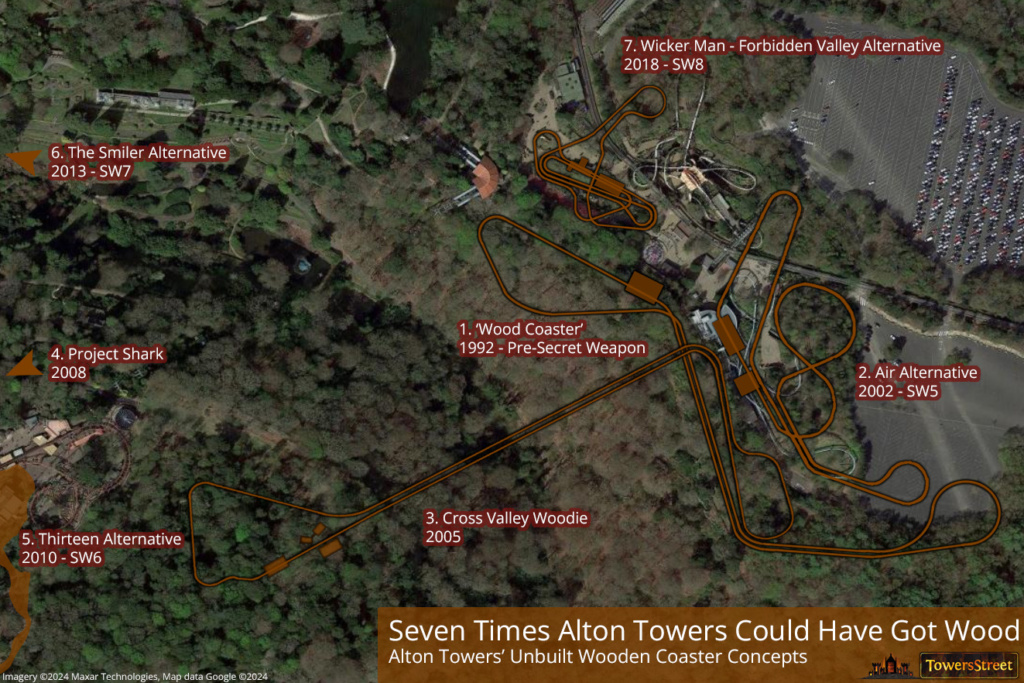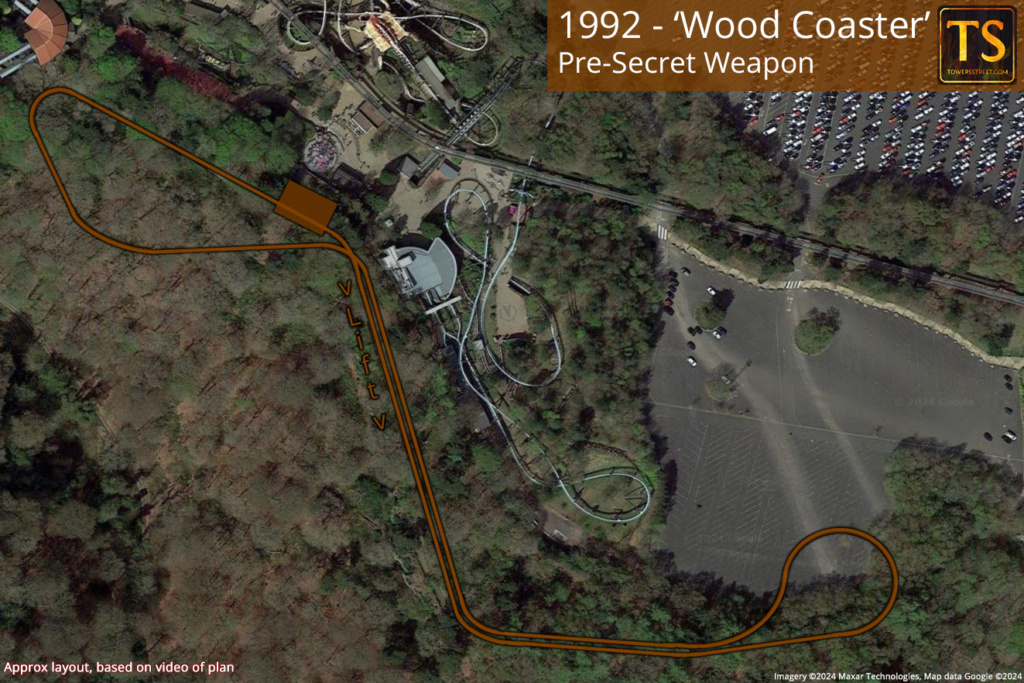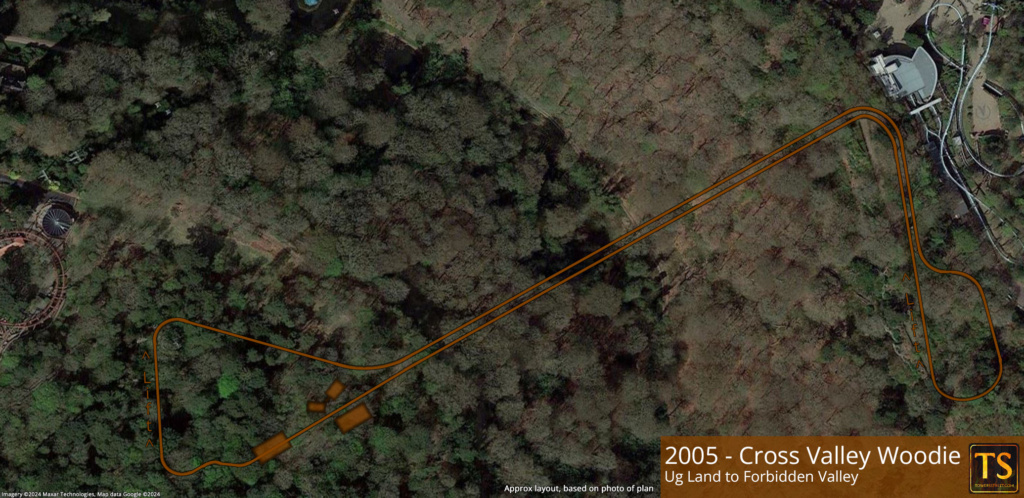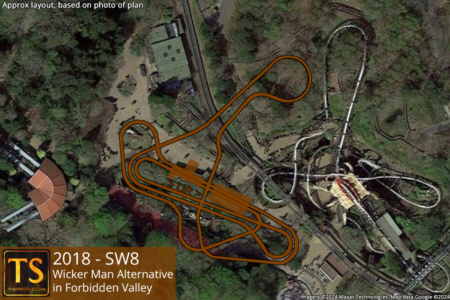In 2018 Alton Towers finally got a chance to build Wicker Man, their first wooden coaster.
But did you know that a woodie had been considered for almost every major coaster since 1990, when Tussauds planned to add a wooded coaster in Thunder Valley as their first major investment in the park? Here we take a look at seven unbuilt wooden coasters from Alton Towers’ past.
1992 – ‘Wood Coaster’
Pre-Secret Weapon – ‘Wood Coaster’ (Developed in 1990)
It is well known that when Tussauds bought Alton Towers, their first big addition was The Haunted House in 1992, with their first coaster addition being Nemesis in 1994. However, footage has recently been unearthed, that reveals that the original intention was to instead add a Wooden Coaster in 1992.
In rough cuts for Themes Dreams And Scream Machines, uncovered by Euro Theme Park Archive, John Wardley talks about the first rollercoaster he had planned for Alton Towers, which would have been a wooden rollercoaster located in what would become Forbidden Valley, or rather in the woodland directly adjacent.
Themes Dreams And Scream Machines was a documentary that followed the early days of Tussauds ownership and the finished documentary followed John Wardley in 1991 as he developed The Haunted House and Katanga Canyon. However, the rough cuts take us back a few months to 1990 and feature footage of John discussing the plans for the Wooden Coaster they originally intend to add.
The footage shows one of the plans on the drawing board, but the commentary implies that more than one plan was being considered at that time, and at least one of which would have been a Twin Track Wooden Racer. The plans shown in the documentary show a layout that runs along the top of the valley at the end of the Gardens, swooping over the edge of the valley where the ground drops away to allow larger drops whilst keeping the ride below the treeline.
The route of the coaster would have minimised disruption to the woodlands by utilising the path of Quixhill Drive, a long-established path which cuts through the area. More recently, the path was used for part of the Woodland Walk, which once provide park access direct from the Alton Tower Hotel.
At the end of the footage, it is revealed that the coaster plans were dropped and replaced by The Haunted House due to objections from English Heritage, no doubt concerned by the disruption to the ancient woodlands and heritage assets such as the Rock Walk. Whilst it would have been interesting to see a wooden coaster built as Tussauds first big investment, the change in plans ultimately started the series of events that resulted in the construction of Nemesis.
2002 – Air Alternative
SW5 – Air Alternative (Developed in 2000)
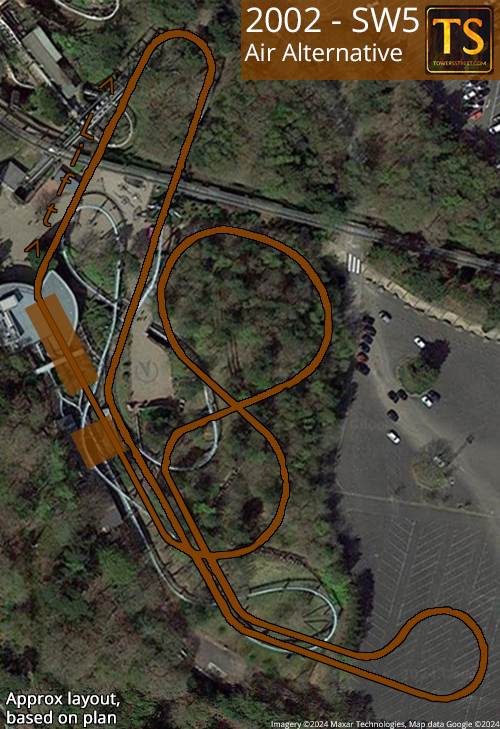
Almost as soon as Nemesis was complete, John Wardley began discussions with B&M, regarding a flying coaster that would become Air (project code name SW5). It would take eight years to make the coaster a reality, and it would seem that the prototype ride was not guaranteed to find its home on the site in Forbidden Valley.
Whilst the B&M flyer was always the prime candidate to replace The Beast, in 2000 John Wardley also considered whether a Woodie might be an alternative use for the space. It is not clear as to what prompted the consideration of other ride types, but it is possible that, as the date approached when they needed to sign off SW5, Tussauds were getting cold feet whether a prototype for the B&M flying coaster would be possible for a 2002 debut. Alternatively, they may have simply been undertaking the due diligence of comparing different uses for the site, rather than railroading themselves into the prototype coaster without considering alternatives.
Either way, in February 2000, John Wardley produced a layout for a Wooden Coaster on the SW5 site. The layout would have more or less used the landscape of the area we see today, and would have had some similarities to the layout of Air, notably the ride’s lift-hill would have had a near identical orientation.
The wooden coaster would have used the landscape a little more, with a figure-8 configuration built onto the berm between Forbidden Valley and the car park. Another notable difference is that, whilst Air’s final turn extended the park’s boundary into the car park, the wooden alternative would have extended the boundary even further for its mid-course switch-back element.
It is not known whether the woodie was ever in serious contention to become SW5, but the idea was certainly short-lived and by August 2000 planning permission had been submitted for Air, and the rest is history.
2005 – Cross-Valley Woodie
Cross Valley Woodie (Proposed in 2003)
At the heart of Alton Towers there is a 200ft valley, which is a defining feature of the local landscape and the parkland laid out by the Earls of Shrewsbury. It is this valley that contains the Grade I listed gardens, but beyond the formal gardens is an ancient woodland, which is part of the more informal gardens criss-crossed with leafy walks and nature trails, where the Battle of Slain Hollow reputedly took place in Saxon times.
Probably the most infamous and certainly the most audacious Alton Towers project that never got built, in 2003 John Wardley proposed adding a gargantuan wooden coaster that would cleave through this ancient woodland between what was then Ug Land and Forbidden Valley. The proposal would have used the natural landscape of the valley to allow a coaster with two drops, which would have been slightly higher than Oblivion and the largest the park is ever likely to achieve.
The coaster’s station would have been located some distance within Abbey Wood, the woodland that surrounds Dark Forest, and would have been entirely constructed in land not currently used as part of the theme park. A lift hill would have taken the train up to tree height level, before the first drop plunged into the valley and up the other side emerging and turning right alongside Air’s Station, the course would then have turned at right angles, running alongside Air, before a turnaround and taking a near reversed journey back through the valley and back to the station.
The park submitted plans in March 2003, and given the ride is on this list, it is safe to say the proposal did not go down well. For various reasons, the plans were withdrawn before the council had a chance to make a decision on the proposals, and they were shelved in favour of Rita – Queen of Speed.
The idea of a cross valley ride was also included in 2012’s Long Term Development Plan, but Merlin have never formally acted on this idea, nor elaborated if the reference was still related to a wooden coaster, or some other type of ride.
For more information on the infamous Cross Valley Woodie, Theme Park Tourist discuss it as part of their Tales from the Towers series, a series in which they also share information about another of the park’s expansion plans from this period, Project Shark.
2008 – Project Shark
Project Shark – Coaster Corner (Proposed in 2006)
In 2005 Tussauds were acquired by the private equity division of Dubai International Capital (DIC). The DIC years at Alton Towers (2005-2007) can be characterised by a flurry of proposals that were announced but ultimately never came to pass.
Project Shark was one such proposal and would have brought a new family-thrill area to the park for 2008, as a counterpart to DIC’s more family-friendly proposals of Project Dolphin.
Project Shark was the code name for a new area at Alton Towers, which would have been located on the former site of Coaster Corner, in the backstage area behind Cred Street. The area would have been home to a Wooden Coaster, a Chute the Chute attraction (similar to Tidal Wave at Thorpe Park) and a flat ride, expected to be a Frisbee. The ride was compared to Megaphobia at Oakwood, so it seems as though it would have been a family-thrill coaster, and therefore probably of a similar scale to Wicker Man.
Not much is known about the detail of Project Shark and, unlike most of the other projects proposed by DIC, no concept art was released for the project at the time. The first rumblings about Project Shark started in November 2006, and it is not clear how much development work had occurred by March 2007 when Tussauds were purchased by Merlin and the project was immediately shelved.
The site where Project Shark would have been located remained backstage for almost 20 more years, though Merlin now have permission to build Project Horizon in this location.
2010 – Thirteen Alternative
SW6 – Thirteen Alternative (Proposed in 2008)
 After Merlin took over Alton Towers, one of their first major projects was SW6 – a replacement for the iconic Corkscrew (and associated retheme of Ug Land). In 2008, to kick off this process they commissioned customer research to identify what types of rides and themes might resonate well with their audience, including mood boards and concept art to illustrate the different options that were on the table.
After Merlin took over Alton Towers, one of their first major projects was SW6 – a replacement for the iconic Corkscrew (and associated retheme of Ug Land). In 2008, to kick off this process they commissioned customer research to identify what types of rides and themes might resonate well with their audience, including mood boards and concept art to illustrate the different options that were on the table.
Whilst this process directly led to the development of Thirteen, the results of this consultation went on to define the direction of travel for the following decade of development at Alton Towers. The concepts shown during these consultations would go on to feature in many subsequent projects at the park, including Nemesis Sub-Terra, The Smiler, Altonville Mine Tours and eventually Wicker Man.
The coasters being considered for SW6 ranged from innovative, such as the Vekoma Dragonfly or Tilt Coaster, through to more established types, including the option of a Wooden Coaster. As part of the customer research, the park produced concept art of a woodie crashing through the Dark Forest and described the proposition as:
“A rip-roaring, fast and furious coaster. Whilst it has no inversions, it features some incredibly steep drops, some extreme banking (70 degrees), and is able to provide real air time, and/or a continuous fast and unrelenting ride. It is the ultimate wind-in-your-hair ride experience – (for all the family).”
Had the park opted for a Wooden Coaster for SW6, the concept artwork featured a train from Thunderhead at Dollywood, suggesting that Great Coasters International, who eventually went on to build Wicker Man, would have been the intended manufacturer. Based on the description and concept art, it is likely that the resulting coaster would have been more thrilling than the coaster we ended up with for either Thirteen or Wicker Man.
It is unfortunate that Merlin did not take this option for SW6, as it is easy to believe that a GCI Wooden Coaster, themed to the Dark Forest, careening along Thirteen’s route out into Abbey Wood would have been quite the experience and would easily have been a fitting replacement for the iconic Corkscrew.
2013 – The Smiler Alternative
SW7 – The Smiler Alternative
In his book, Creating My Own Nemesis, John Wardley reveals he had one last stab at being allowed to design a Wooden Coaster for Alton Towers. When options were being considered for the 2013 addition, John once again pitched that “a traditional wooden coaster would be an absolutely perfect addition for the park”.
At this point it was not a foregone conclusion that SW7 would be in the X-Sector, so it is not clear if John Wardley was considering adding a woodie on the Black Hole site, or if he had another location in mind. Equally, it is not clear if he ever put pen to paper to sketch a proposed design before the plan was vetoed.
Unfortunately, the weight of opinion was against him. In particular the marketing team, who were not used to trying to sell a coaster without a ‘world’s first’ element, felt they would struggle to create a compelling marketing campaign for a ride type that might be considered ‘old-fashioned’.
The situation was not helped by the approach of Nick Varney, who had also come from a marketing background and whose main criteria for green-lighting big new additions reportedly required them to have a ‘Unique Selling Point’ accompanied by a killer image (i.e. they were easy to encapsulate in a single image and sell on short form social media).
And so the project went in another direction, eventually landing on The Smiler with its 14 inversion USP.
2018 – Wicker Man Alternative
SW8 – Wicker Man Alternative (Proposed in 2015)
When the time came to consider SW8, the mood had changed within Merlin, since wooden coasters were very much back on trend.
However, Wicker Man as we know it today was not the only option under consideration. In 2015, a year before the park sought planning permission for Wicker Man, the park submitted a formal Environmental Impact Assessment (‘EIA’) screening opinion for an alternative site in Forbidden Valley. In the associated EIA opinion, the proposal is described as:
“Demolitions and removal of existing buildings and ride structures. Construction of new ride including tunnels, ground level changes, maintenance building, station, shop and pre-show building.”
If this version of SW8 had gone ahead it would have seen the removal of The Blade, as well as the other structures in and around the old Thunder Looper pit, which would have been somewhat enlarged to make way for the new coaster. The lift hill would have run roughly along the original axis of the Thunder Looper, with a secondary highpoint and turn around in between Nemesis and Sub-Terra, on the site of the Nemesis overflow queue.
At the time of the Forbidden Valley submission, it is not clear if Alton Towers had yet decided on their preferred manufacturer for their wooden coaster, with The Gravity Group also under consideration for the project. It is also unknown if the park had made any decisions regarding the coaster’s theme, although clearly they were expecting the coaster to have a pre-show, much like Wicker Man, so the coaster would certainly have had a story-telling element to it.
To pursue a coaster on this site would have required full planning permission due to the size and scale of the coaster falling outside the General Development Order in place for Forbidden Valley, which allows small scale construction up to 5m in height. However, whilst the council concluded that an EIA would not be needed to be included in planning permission for the site, by the start of 2016 plans for SW8 had changed.
In the meantime, The Flume had been retired at the end of the 2015 season, and the park had clearly decided to look at redeveloping this prime piece of park real estate as the site of SW8. A second EIA screening opinion was sought in April 2016, this time reflecting that the park were looking to build their wooden coaster at the edge of Mutiny Bay.
It is not clear if the Forbidden Valley option was still under consideration when the second EIA screening opinion was sought but, if it was, the plans swiftly pivoted in favour of the Wicker Man site in Mutiny Bay and full planning permission for the site was sought in May 2016.
And so Alton Towers’ near 30 year quest to build their first wooden coaster came to fruition with Wicker Man. But with the success of the ride, it almost certainly won’t be the last woodie to come to the park.


